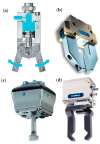Robotics and Aseptic Processing in View of Regulatory Requirements
- PMID: 37376030
- PMCID: PMC10305582
- DOI: 10.3390/pharmaceutics15061581
Robotics and Aseptic Processing in View of Regulatory Requirements
Abstract
Several nanomedicine based medicinal products recently reached the market thanks to the drive of the COVID-19 pandemic. These products are characterized by criticality in scalability and reproducibility of the batches, and the manufacturing processes are now being pushed towards continuous production to face these challenges. Although the pharmaceutical industry, because of its deep regulation, is characterized by slow adoption of new technologies, recently, the European Medicines Agency (EMA) took the lead in pushing for process improvements using technologies already established in other manufacturing sectors. Foremost among these technologies, robotics is a technological driver, and its implementation in the pharma field should cause a big change, probably within the next 5 years. This paper aims at describing the regulation changes mainly in aseptic manufacturing and the use of robotics in the pharmaceutical environment to fulfill GMP (good manufacturing practice). Special attention is therefore paid at first to the regulatory aspect, explaining the reasons behind the current changes, and then to the use of robotics that will characterize the future of manufacturing especially in aseptic environments, moving from a clear overview of robotics to the use of automated systems to design more efficient processes, with reduced risk of contamination. This review should clarify the regulation and technological scenario and provide pharmaceutical technologists with basic knowledge in robotics and automation, as well as engineers with regulatory knowledge to define a common background and language, and enable the cultural shift of the pharmaceutical industry.
Keywords: GMP; annex 1; automation; nanomedicines; pharmaceutical processes; robotics; sterile manufacturing.
Conflict of interest statement
The authors declare no conflict of interest. The company had no role in the design of the study; in the collection, analyses, or interpretation of data; in the writing of the manuscript, and in the decision to publish the results.
Figures











References
-
- European Medicines Agency Reflection Paper on Nanotechnology-Based Medicinal Products for Human Use. [(accessed on 16 May 2023)]. Available online: https://etp-nanomedicine.eu/wp-content/uploads/2018/10/reflection-paper-....
-
- Considering Whether an FDA-Regulated Product Involves the Application of Nanotechnology. [(accessed on 16 May 2023)]; Available online: https://www.fda.gov/regulatory-information/search-fda-guidance-documents....
-
- COMMISSION RECOMMENDATION of 10 June 2022 on the Definition of Nanomaterial (2022/C 229/01) [(accessed on 16 May 2023)]. Available online: https://eur-lex.europa.eu/legal-content/EN/TXT/HTML/?uri=CELEX:32022H061...
Publication types
LinkOut - more resources
Full Text Sources
Research Materials

